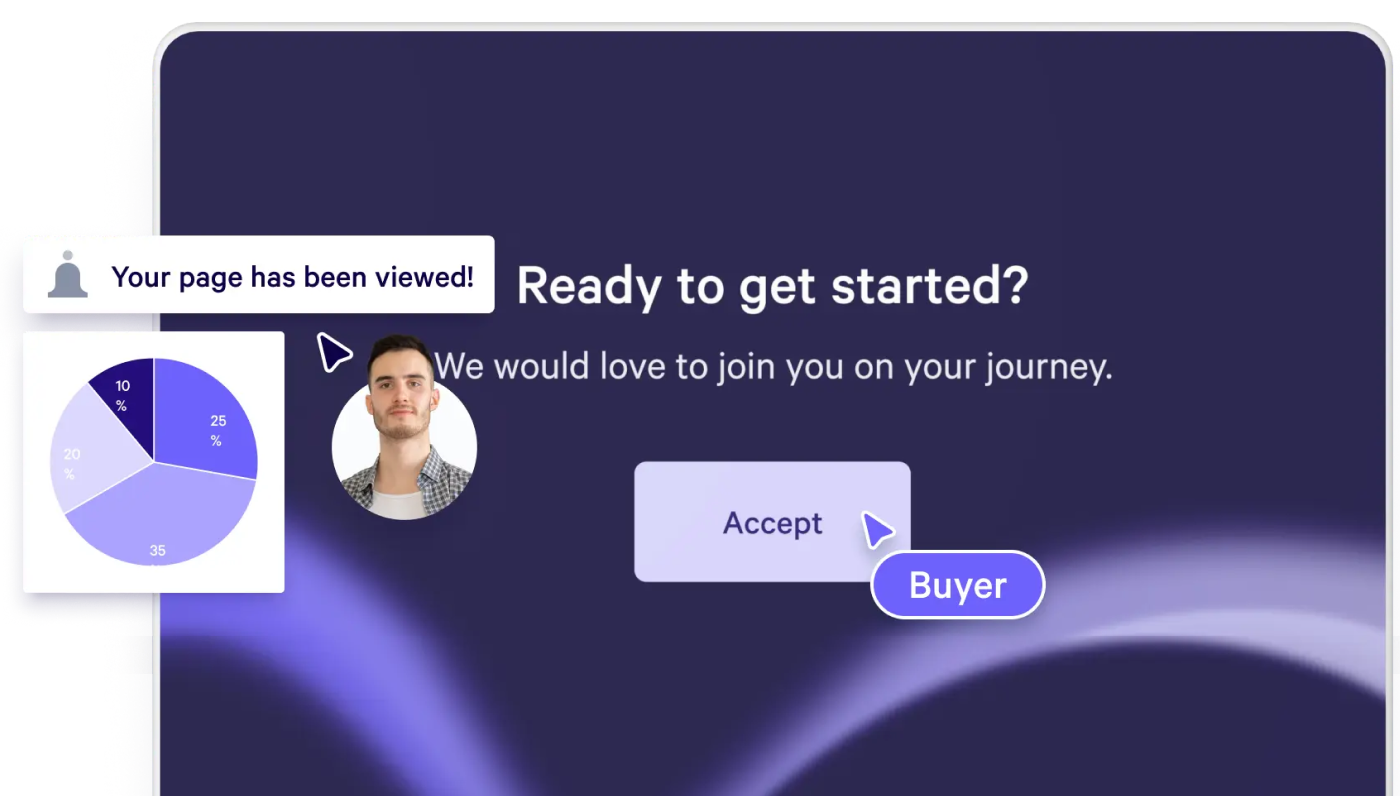
The work that secures your business starts long before your sales team send that quote.
How you present yourself lays the essential groundwork; while a skillful closing technique ensures you can close the deal when you get that far.
I’m sure there’s a metaphor that illustrates this point with much more finesse than I have here, but for the life of me, I can’t think of it. I do, however, have decades of experience making and closing deals. So- in a rather obvious attempt to redeem myself- here is my guide to all these key elements in turn…
Establishing your brand and value proposition
Align your brand and value proposition
When it comes to building a strong brand, it's crucial to ensure that your messaging aligns with your value proposition. Your brand is the face of your business, and it communicates a lot about what customers can expect from you. From your logo to your tone of voice, every element of your brand should work together to create a cohesive and compelling image that resonates with your target audience.
But it's not just about aesthetics. Your brand should also accurately reflect your value proposition - the unique benefits and solutions you offer to your customers. If your branding sends mixed signals or creates confusion about what you stand for, you risk turning off potential leads and missing out on valuable business opportunities.
Imagine a small business with a website that looks so expensive that customers assume they can't afford their services. This kind of disconnect between branding and value proposition can be a major obstacle to growth. On the other hand, if your business is focused on delivering value and affordability, your branding should reflect that message loud and clear.
Striking that balance is all-important. You don't want to attract customers who aren't a good fit for your business, but you also don't want to miss out on opportunities to connect with potential leads. It’s a fine line to skate. But by aligning your brand and value proposition, you can create a powerful marketing message that speaks directly to your ideal customers and sets your business apart from the competition.
(Oh, and if that all feels a little ‘fuzzy’ or abstract, and you need a little more convincing, a comprehensive study by Lucidpress equated brand consistency with an average revenue increase of 33%!)
Know what work you want to do, why, and at what price
Keeping a conscious understanding of your value proposition is essential for shaping how customers perceive your business, how you pitch to them, and how they respond to your message. It also ensures that your branding and marketing efforts are aligned with your core values and goals.
Take time to establish your pricing strategy. If you are a boutique consultancy firm charging top dollar, geared solely towards high-paying or prestige projects, then set your stall out - make sure your branding and your value proposition reflects who you are and never wavers.
In short: know what work you want to do, why, and what price.
Make it as easy as possible to collect and qualify inbound leads
Generating inbound leads - potential customers who find your business without you having to seek them out actively - can be a challenging and costly process. That's why it's essential to make the most of every opportunity to connect with potential leads once they've found their way to your website, Facebook page, or other listing.
Once you gain a potential lead's attention, it's essential that you engage them and keep their interest. This means developing a compelling sales pitch that clearly communicates what your business can offer.
You also need to ensure your website, social media pages, and online listings are optimized for user experience. This includes everything from easy navigation and clear calls-to-action, to fast loading speeds and mobile responsiveness. A shoddy customer experience will fatally undermine all the effort made to get your prospect there.
CRM’s can be a great way to utilize automation AND personalize here. By providing a seamless and engaging user experience, you can increase the chances that potential leads will stay on your website or social media page long enough to learn more about your business and what you have to offer. And by crafting a compelling pitch that speaks directly to their needs and pain points, you can turn those leads into closed sales deals and loyal customers who are eager to do business with you.
Don’t put up barriers to potential customers speaking to you
We discussed the importance of using branding to attract the type of customers that you want. Once you’ve worked this hard to get their attention, you need to make it as easy as possible for them to reach out to you. This seems obvious, but it’s a mistake I see made every day.
That means offering them more than just the bog-standard “contact us” form. Let them meet you where they are most comfortable. Be that email, phone, or social media (even LinkedIn).
For example, something as simple as adding a QR Code with an effective CTA on your business card design can go a long way in ensuring your prospects are able to save and access your contact information with ease.
The customer experience has always been key, but even more as the world has gotten smaller and increasingly digitized.
By forcing customers to communicate with you in a specific way, you risk creating unnecessary barriers to entry and turning off potential leads just when they have finally found their way to your door.
Be able to tell quickly whether a lead is worth pursuing
By developing a strong brand, you filter out irrelevant leads before they even reach you, saving precious time at every point of the sales process. This can be anything from clearly communicating your value proposition and target audience through your branding and marketing efforts, to pricing transparency for weeding out clients who aren't a good fit for your business.
For example, freelance web developer Dylan found that saying "no" to work that didn't fit his value proposition was one of the most valuable things he could do. It seems counter-intuitive, but it’s actually big-picture thinking. By focusing on large projects for large clients, he was able to attract high-quality leads and avoid the time and energy associated with serving clients that weren't a good fit.
With transparent pricing and minimum job size qualifying his leads, he could filter out potential clients who weren't willing or able to meet his minimum standards. This sales strategy saved him a lot of time and energy, and allowed him to focus on serving clients who were a good fit for his business.
Once you engage leads, work to understand the problem they want you to solve, and offer to solve it
To truly win more work and build a successful business, you need to understand your prospect’s problems and why they believe that you can solve it.
Sometimes what the customer actually needs is not actually what they are asking for. We had first-hand experience of this very issue when Qwilr was in its infancy. Eager to make a slick, professional first impression, we went out looking for some embossed cards. (Nothing says slick and professional like embossed cards…) The only bump in the road was the pricing. Every quote we asked for was coming back over-budget. One customer, however, actually dug down into our problem on a sales call, separating out what we were asking for and what we actually needed. And what we needed were “cards that look professional and met our budget”.
All the printers who just responded didn’t get our business. The printer who worked to really understand our problem, did.
To win more work and build a successful business, it's crucial to understand your prospect’s needs and constraints and offer a solution that meets them. It does require a little more effort, but it is an effort that pays for itself many times over.
And those are the aspects of a sales deal that put you in a position to close a deal. That gives you a deal to close, in fact. Now we’ll have a close look at five of the very best sales closing strategies to get that deal over the line.
‘Closing time’: 5 tried-and-tested sales closing techniques
The Assumptive Close
The assumptive close is a powerful sales technique that requires a high level of confidence in both yourself and your product. Rather than asking the question close, where you ask the prospect if they are ready to buy, you proceed with the assumption that they are interested in making a purchase, and the deal is essentially sealed. To execute this technique effectively, it's crucial to strike a balance between assertiveness and aggression, as being too pushy may damage the rapport and scare off the prospect. Timing is key for this hard close- after emphasizing the benefits of your offer, follow up straight away with the assumptive close (and closing questions) so that it remains fresh in the prospect's mind.
The Alternative Close
This technique involves presenting prospects with two or more buying options to help close a sale. It's a way to make the prospect feel in control of the decision-making process, but in reality, the salesperson can still subtly guide them toward the option they want them to choose.
Say a prospect is hesitant about the price and is looking for certain features, the salesperson can suggest two options: the more expensive Pro plan, which includes free onboarding and six months of free support, or the Basic plan, which starts at $30 per month but has fewer features and no free support. This way, the prospect feels like they have a choice, but the sales rep is still able to guide them toward the more expensive option.
The Now or Never Close
The Now or Never Close is a sales technique that encourages prospects to commit to a purchase within a specified time frame, such as the end of the day. This sales tactic can involve offering an add-on that is only available for a limited time, such as the last remaining product, a discount for those who commit today, or priority in the implementation queue for those who sign up immediately. The idea behind this technique is to create a sense of urgency by making the prospect feel that they will miss out on a valuable opportunity if they don't sign a contract today.
This approach works best when you have the flexibility to offer discounts and when dealing with prospects who may be hesitant due to a lack of time. However, it's important to avoid using this approach when the prospect has made it clear that they are not interested or when you are unable to offer a compelling incentive.
The Summary Close
The Summary Close is a particularly effective sales technique in B2B sales, where sales cycles can be lengthy. Prospects who are considering multiple vendors and products may struggle to recall all of the key benefits of your solution. In a Summary close, you recap the features of your product features and how it will address the prospect's specific needs. This approach provides the prospect with a final opportunity to visualize the potential impact of your product before making a decision. By emphasizing the key benefits of your solution in a clear and concise manner, you can help the prospect to make an informed and confident decision.
The Puppy Dog Close
This technique is based on the idea that if a pet store offered to let you take a puppy home for a few days to test it out, you would fall in love with it and never want to give it back. Similarly, in a Puppy Dog Close, the sales professional offers a free trial of their product with no strings attached.
The idea behind this technique is that the prospect will find the product so darn indispensable during the trial period that they won't want to part with it once the trial is over. It's a way to let the product speak for itself and demonstrate its value, without any pressure on the purchase decision or commitment from the prospect.
Final thoughts
To close a sales deal, you need to lay the groundwork, usher them through your sales funnel, and then get it over the line with a solid closing technique.
- Win before the quote with your strong branding, fast engagement with leads, and genuine investment in solving your client’s problems.
- Make it clear what work you do, why, and at what price.
- Make it easier for you to find real prospects, and it easy for them to contact you when you have.
- Understand your customer’s problems and explain how you’ll solve them.
- Get the decision-makers signature on the dotted line with the most appropriate ‘Closing Time’ technique.
And if you found this useful, read our guide on how to shorten your sales cycle, where we have a selection of our best free sales advice and sales tactics for getting your prospects from A to B. Faster.
About the author

Brendan Connaughton|Head of Growth Marketing
Brendan heads up growth marketing and demand generation at Qwilr, overseeing performance marketing, SEO, and lifecycle initiatives. Brendan has been instrumental in developing go-to-market functions for a number of high-growth startups and challenger brands.



